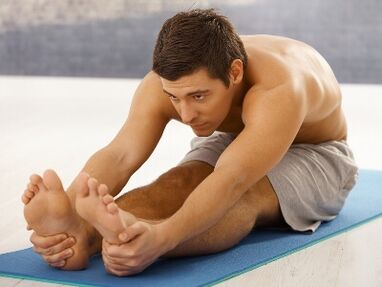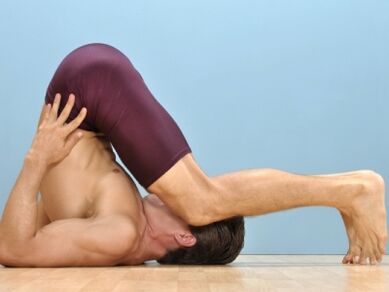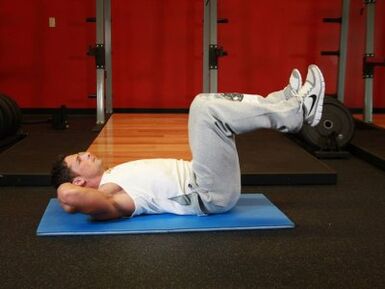
Prostatitis and benign prostatic hyperplasia are very common in older men.
The main symptom of prostate adenoma is difficulty urinating due to compression of the urethra.
In addition to drugs in the complex treatment of these diseases, folk remedies, such as the use of dead bees for prostate adenoma and surgical methods, as well as therapeutic exercises to prevent blockage and inflammation are recommended.
Special exercises for prostatitis and prostate adenoma should be done for a long time. They are aimed at strengthening the muscles of the pelvis, perineum, lower extremities, the general strengthening of the body.
Exercises recommended for prostatitis and prostate adenoma in men after prostate surgery are also indicated to prevent complications. In this case, they should be carried out gently and taking into account the well-being of the patient.
Physiotherapy for prostate adenoma: basic complexes of physical exercises

Physical therapy for prostate adenoma, as well as massage improves blood circulation in the pelvic organs.
This can stop the development of the pathological process and reduce the growth rate of a benign tumor.
Training for prostate adenoma includes static and dynamic exercises.
General strengthening exercises such as walking, running, cycling are called dynamic movements. It is also worth doing exercises such as squats, walking on the hips, rolling on the ball, lifting the legs or lifting the pelvis while lying down.
Static exercises include standing positions with prolonged tension of a certain muscle group.
It is useful to note
It is important to strengthen the back and abdominal muscles. To do this, exercises are performed in a supine position, sideways, on the stomach, with twists and push-ups. One of the most effective exercises, with a raised pelvis - is a bicycle in a stretched position to complicate training.
All kinds of lifts and inclines, pelvic rotations are useful. There are special sets of exercises aimed at the muscle group of the perineum.
The most popular and effective exercise kit for prostate adenoma is the Kegel complex, created by a gynecologist for women and modified for men. Its main exercises are performed on the legs and stretching, training the muscles of the anus and perineum, aimed at preventing blockage of the perineum and small pelvis.
The complex should be performed in the morning, after hygiene procedures and in the evening. With prostate adenoma, it is recommended to exercise 2-3 hours before bedtime.
Note
Training for prostate adenoma should be done taking into account the patient's well-being, not overloading and forcing him to move forward, the complexity of the exercises must take into account the patient's age and agree with the attending physician.
Properly selected set of exercises for the prostate gland after surgery can be a significant help in the postoperative recovery period. Training should be regular.
The set of exercises itself does not require much time, but its regular use has a positive effect on the general condition of the male body and blood circulation in the pelvic organs, reduces the severity of congestion and edema.
Also, strengthening the abdominal and perineum muscles has a positive effect on the process of urination and will be an excellent prevention of prostate adenoma in the future.
Important
Gentleness should also be remembered when performing exercises, they should bring pleasure and light fatigue, but should not be accompanied by painful feelings or force.
Therapeutic gymnastics for prostate adenoma

Gymnastics recommended for prostate adenoma may be useful not only for benign prostatic hyperplasia, but also for patients who have undergone prostate cancer surgery for chronic prostatitis.
In combination with drug therapy, physical therapy can help reduce edema and congestion in the small pelvis and, accordingly, reduce obstruction of the urethra and improve urinary excretion. Therapeutic gymnastics or exercise therapy for prostate adenoma is performed in groups under the supervision of a specialist, often in medical institutions, and consists of three stages.
The first stage involves general physical activity such as aerobic exercise, running, jumping and warming up.
In the second stage, special exercises are performed to strengthen the muscles of the back, abdomen, perineal region, which help to empty the bladder. Various exercises are also performed to reduce pelvic congestion.
In the third stage, stretching and relaxation of the loaded muscles is achieved during training.
Note
To achieve a stable effect, this course of exercises should be carried out regularly and last a long time. Physiotherapy training techniques must be included in a set of therapeutic measures, including drug treatment, physiotherapy and, if necessary, surgery.
Proliferation of glandular tissue of the prostate gland is an age-related disease, the course of which depends on the health and safety of the body.
Adherence to a healthy lifestyle, regular exercise, proper nutrition and diet, avoidance of bad habits have a great impact on quality of life and have a positive impact on both the onset and course of the disease.
The habit of maintaining physical activity and the use of existing exercises allow you to maintain the functions of organs and systems for a long time, even in old age.
























